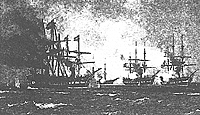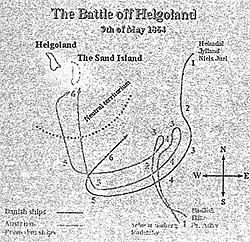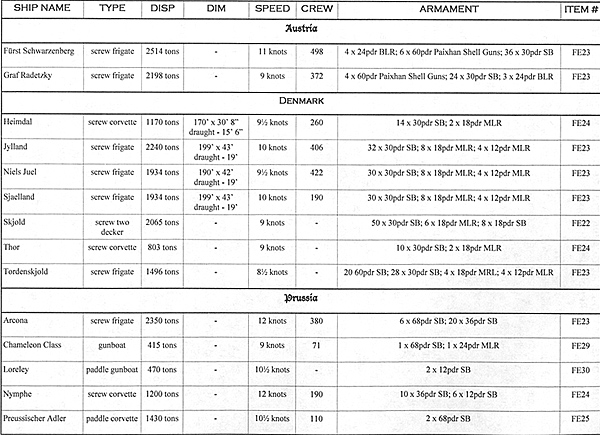
Introduction
This article attempts to enlighten gamers to the 1864 European conflict known variously as the German-Danish War, the Second Schleswig-Holstein War, and the Second Schleswig War. Naval gamers will find that this war's two major naval actions (Swinemund and Helgoland) to be very playable scenarios, this war being the last time two exclusively wooden fleets would engage in European waters.
The historical background of this war comes from several sources. First, I would suggest picking up a copy of Nigel Smith's excellent work, The Second Schleswig War, published by Picklehaube Press and reviewed by me in MWAN 96. This paperbound booklet is an invaluable reference to this war, both on land and at sea. You can purchase this title from On Military Matters.
Also, there are two websites that bear mentioning. Anyone with any interest in this period (land or sea) must simply visit the Danish Military History website (http://www.milhist.dk/). Not only is the Helgoland action covered, but there are ship details and artwork as well. The second site (http://www.kultumet.dk/homes/orlm/kroneng4.htm) is a single page website with a brief naval history regarding both the 1848 and 1864 wars.
The table at the end of this article gives as much information as I could find regarding the ships that took part in this war. While fairly complete, there are some gaps in the information, which will have to be guesstimated to convert to your favorite set of naval rules. Myself, I plan to use Canis Publishing's Smoke on the Water along with Figurehead's 1/2400th scale ships. The rules are designed for the American Civil War, so the weapons and technology are on par with the German-Danish War. As these rules are written for 1/600th scale ships, I would suggest using the alternate 1/1200 charts to give a better representation of sea scale. I have used Smoke on the Water exclusively for ACW naval gaming for several years, and they are very easy to learn and give good historical results, a bonus when running events at convention settings.
Historical Outline
In 1864, Denmark was involved with its second war in the Schleswig-Holstein region, this time against Prussia, Austria, and to a much lesser extent, Saxony and Hannover. The war had not been going well for Denmark due to the numerical superiority of the German states arrayed against it. However, the Danish did have a strong fleet, and was able to blockade the harbors of Schleswig and Holstein and later was able to extend that blockade to the Prussian Baltic Sea area. The Danish Baltic Sea Squadron took up a position 15 miles offshore in the middle of Stettin Bay. This blockade was very effective during daylight hours, but there was some blockade running at night.
The weaker Prussian navy had to ask for assistance from Austria, who sent a squadron in response (comprised of the frigate Farst Schwarzenberg and the gunboat Seehund). This squadron headed for the war zone under the command of Commander Wilhelm von Tegetthoff at the beginning of March. The Danes had knowledge of this force through their legations at Madrid, Paris, and London, so accurate that the Ministry of Naval Affairs knew whenever the Austrians arrived or departed from a harbor.
Battle of Swinemund
Meanwhile, the Prussians attempted to break the Danish blockade on their own. On the 16th of March the Prussian squadron under command of Captain Jachmann and consisting of the frigate Arcona, the corvette Nymphe, the paddle gunboat Loreley, and six Chameleon class gunboats, set out to sea at Swinemiind. The next day they engaged the Danish Baltic Squadron off RUgen. The Danish squadron consisted of the screw frigates Sjaelland and Tordenskjold, along with the screw corvettes Heimdal and Thor, and the two-decker Skjold, all under command of Rear Admiral Van Dockum. Jachmann sent his gunboats to the northwest, close to the coastline, and moved his larger ships to the east to scout for any Danish ships that might try to cut off his flotilla from its base. Jachmann then made a sharp turn to the northwest and headed towards the Danish anchorage. Around 2:00 p.m. the Danes weighed anchor and moved to engage the oncoming Prussians.
The Prussians, unaided by their gunboats, steamed line abreast, with the Loreley in the middle of the formation. Making a starboard turn to the east, Jachmann hoped to entice the Danes into a running fight back to Swinerniind. The Sjaelland was the first Danish ship to engage as she turned starboard to fire a broadside on the Arcona who had also turned to fire a broadside on the ~jaelland before turning away to the south. This maneuver by the Arcona caused the other two Prussian ships to turn about, and due to the Loreley's slow approach speed, caused the Arcona to be dangerously separated from the rest of the Prussian ships.
Seeing this opportunity, the Sjaelland steered to interpose herself between the Arcona and the Nymphe. However, the Sjaelland took so much damage from the two Prussian ships she was forced to hold back until the rest of the Danish squadron could catch up. This delay allowed the outmatched Prussian fleet to slip away. The Sjaelland, closely followed by the S4old, continued to engage the Prussians at extreme range, causing hits on all three Prussian ships, which forced the Loreley to take refuge inshore. However, the range continued to increase, and at 4:45 p.m. the Sjaelland had fired her last broadside. By 8:00 p.m. the last Prussian ship had made it safely back to port.
The main result of this battle was to prove that the Prussians could not engage the superior Danish navy without help from Austria, which was soon forthcoming. The Sjaelland suffered 3 dead and 19 wounded, while the Arcona and Nymphe had combined casualties of 5 dead and 8 wounded. The Prussian navy in the Baltic made no further sorties from port.
 Battle of Helgoland
Battle of Helgoland
Von Tegetthoff had stopped at Lisbon waiting for the arrival of a second Austrian squadron under command of Rear Admiral Baron von Wiffierstorf-Urbair. After waiting in vain for the Baron's squadron to join him, von Tegetthoff decided to press on for the English Channel. At Brest the frigate Graf Radetzky and the gunboat Wall joined him. April 24th found von Tegetthoff s reinforced squadron coaling in the Downs. The Austrians sailed for Nieuwediep in Holland where they were joined by the Prussian gunboats Blitz and Basilisk, and the paddle corvette Preussischer Adler.
The Danes had on March 30th formed the North Sea Squadron, under command of Commander Edouard Suenson. Suenson was to protect Danish commerce, seize German shipping, and prevent any enemy warships from entering the North Sea. The squadron consisted of the frigate Niels Juel and the corvette Heimdal. They were to join with the corvette Dagmar. On April 6th Suenson left Copenhagen and arrived in the North Sea a few days later. To strengthen this squadron, the frigate Jylland was ordered into the North Sea in the beginning of May to take the Dagmar's place. On May 5th the Jyllandjoined the Niels Juel and the Heimdal with orders to turn south at once and intercept the Austrian squadron which had reportedly left Texel.
Von Tegetthoff, less the Seehund who had put into London to repair damage, left Holland on May 3rd, having been kept in port due to bad weather. The combined Austrian-Prussian squadron was able to slip past the Danish North Sea Squadron (at the time in Kristianssand in Norway) and head into Cuxhaven. On May 9th, having received word that the Danes were on station near Helgoland (a British island), von Tegetthoff sailed out to meet them. (Somewhere along the voyage to the North Sea the gunboat Wall was left behind)
Shortly after 10:00 a.m. a Danish lookout on the Niels Juel spotted smoke from the southwest. Within an hour, it became apparent that it was the German squadron steaming north. The Danish squadron picked up speed and prepared for battle. On the flagship Niels Juel a signal was hoisted, and the Jylland and Heimdal took up positions on both sides of the flagship. Suenson pointed in the direction of the smoke, and seeing the masts of the Genrian ships, called out in such a loud voice to be heard on all three ships "Men, there are the Austrians. Now we will meet them. I trust that we will fight like our brave comrades at Dybbol." The Danish ships then fell into line astern formation.
At about the same time that Suenson was giving his speech, von Tegetthoff was addressing the men aboard the Fu,,rst Schwarzenberg, saying "Our armies are victorious, we will be the same." The Austrians manned their guns, ships falling into line, with the Prussian vessels a little further away.
At 1:45 p.m. the Schwarzenberg opened fire on the Danish flagship at a range of 4,100 yards, using her front swivel guns. The shells splashed down in front of the Niels Juel. A few more rounds from the Austrian ship followed, but no hits were obtained. The German force was sailing in line abreast, with the Austrian ships on the right of the line, and was attempting to cross the Danish "T", but were thwarted in this attempt by the Danes turning away. This caused both fleets to pass the other on the starboard bow. The Niels Juel could now bring her guns to bear and opened fire. Shortly after the remaining Danish ships joined in and almost at once scored hits on the Schwarzenberg. One of the first shells exploded on the Schwarzenberg's gun deck, causing 14 casualties. The distance closed to 2,000 yards as the two squadrons passed each other. The Prussian gunboats, being on the right of the line, were out of gun range, and therefore the Danish ships concentrated their fire on the Austrian frigates.
After passing, the Danish turned starboard in an attempt to cut off the Prussian gunboats. The Austrians, seeing this danger, immediately turned hard about 180'. Both squadrons were now following a parallel course south, the gunboats still being sheltered to the starboard side of the Austrian frigates. The Austrians turned suddenly to port sailing straight for the Danish line, but were soon forced to turn away due to the intensive fire they received from the Danish guns. The range was now only 1,100 yards. The Danish ships turned slightly to starboard, closing the range to only 500 yards.
The Jylland and Heinnial were concentrating their fire on the Graf Radetzky; the Niels Juel was exchanging broadsides with the Schwarzenberg, which was taking severe damage.
Twice the Schwarzenberg caught fire, the first being put out easily, but the second had set the sail depot above the powder magazine on fire and was only put out with great difficulty. Many of the gun crew had been killed or wounded. The Danish ships in turn were taking damage, the Jylland in particular. One shell had penetrated the hull and exploded close to Gun No. 9, killing and wounding many of that gun's crew. At Guns No. 8 and 10, the crew were shocked at the sight of their nearby comrades, and staggering almost unconscious from the blast of shell, fell back from their guns. Discipline was quickly restored, and Gun No. 9 was recrewed, and soon the guns were back in action.
The battle had raged for nearly two hours, with the Danes slowly gaining the upper hand due to their greater accuracy and rate of fire. Several guns on the Austrian frigates had been put out of action, and as a result their return fire began to slacken. By this point, the Prussian gunboats had obtained the range with their rifled guns, and were able to engage the Danish squadron without suffering from return fire.
The squadrons were approaching the neutral waters near Helgoland, and from the hill of that island as well as from the tops of the foremasts of the British ship Aurora, civilians and sailors alike were watching the battle. The concussion from the guns firing was shaking the windows and doors on Helgoland. Out of the smoke, the spectators suddenly saw a ship with its foretop ablaze.
The Schwarzenberg, having been bit with a Danish shell that set her foretop on fire, was in distress. It was impossible to put the fire out as it threatened to engulf the entire ship. Von Tegetthoff decided to save his flagship and his squadron by seeking the safe and neutral waters off Helgoland. He therefore signaled to the other ships of his squadron to head north.
The Radetzky, attempting to cover the burning Schwarzenberg, continued its course. The Prussian gunboats followed von Tegetthofrs signal, and had broken off from the engagement.
Therefore, the Radetzky was waging an unequal contest with the North Sea Squadron. Von Tegetthoff repeated his orders to disengage, and this time the Radetzky did so. The German squadron steamed at fall speed for Helgoland. The Danes tried to follow the retreating enemy, but as the steering gear of the Jylland had been damaged, the German ships were able to increase their lead. A few more gunshots were exchanged, and Suenson, at 4:30 p.m., gave orders to break off the pursuit.
He did not want to risk violating British territory. By 4:45 p.m. the Gennan squadron was anchored by Helgoland. The Danish ships stayed nearby, ready to resume the battle if the Germans tried to make a run to another port.
Onboard the Schwarzenberg the fire was burning strongly, making attempts to douse it difficult. The foremast had burned down to a stump. The fire was finally extinguished by 1:00 a.m. on the 10th, therefore von Tegetthoff made a run for Cuxhaven. With the lights on all ships out, the German squadron made it safely to Cuxhaven a few hours after setting out. The Danish squadron was nowhere to be seen, returning to Copenhagen (and a hero's welcome) on May 15th.
Damage was severe on the Austrian ships. The Schwarzenberg had lost 32 dead and 69 wounded and was hit 93 times. The Radetzky suffered 5 dead and 24 wounded. The Prussian gunboats hadn't suffered any loss in men or damage to their ships. The Danish had fired 1,746 shells at the German squadron.
On the Danish side, the Niels Juel had taken serious damage, and had lost 4 dead and 21 wounded. The Jylland, besides having taken damage to her steering gear, lost 14 dead and 28 wounded, and the Reimdal had 2 wounded.
Thus, the Battle of Helgoland, while being a Danish victory, had no influence on the outcome of the war. It was the last naval battle in European waters to be fought between exclusively wooden ships.
At the beginning of July, the remainder of the Austrian North Sea Fleet arrived in Cuxhaven. This fleet was comprised of the screw frigate Novara, the battleship Kaiser, and armored frigate Don Juan dAustria, the corvette Erzherzog Friedrich, the paddle steamer Kaiserin Elisabeth, and the gunboat Wall, which had joined the fleet in the English Channel.
With the arrival of this powerful force the blockade of Prussian ports was lifted.
Closing Remarks
While sources are relatively limited in reference to the specific appearance of the ships that took part in the German-Danish War, some basic information is available. Both the Austrian and Danish ships had black hulls and a white gun port stripe. Masts appear to be brown or tan, with black cross masts. The Prussian ships are black, with a yellow stripe along the gun ports.
The line drawing of the Jy1land (right) should give the garner the general appearance of the combatants. If you want to do more research on this European conflict, or if you want to purchase the rules and miniatures mentioned in this article, I have compiled a list of vendors and web sites to assist you. Please mention that you saw their information in MWAN.
Next time, the scenarios of Swinemund and Helgoland!
Vendors
On Military Matters (The Second Schleswig War booklet)- 31 West Broad Street, Hopewell, NJ 08520 (http://onmilitarymatters.com).
Canis Publishing (Smoke on the Water rules)- http://www.canis-publ.demon.co.uk. In the United States, Grandiosity Books and Miniatures, P.O. Box 750992, Dayton, OH 45475 (http://www.warweb.com).
Figurehead Ships (1/2400 scale miniatures) - http://www.hallmarkfigures.freeserve.co.uk. In the U.S., Regal Miniatures, 1980 NW 94th Street, Suite D, Clive, IA 50325 (http://www.regalminiatures.com).
On the Internet
Blood and Iron Egroup, - http://groups.yahoo.com/group/Bloodandlron
Danish Military History - http://www.milhist.dk/
Jylland - http://pc-78-120.udac.se:8001/wwwNautica/ships/Jylland.html
Wars of 1848 and 1864 - http://www.kultumet.dk/homes/orlm/kroneng4.htm
War of 1864 Egroup - http://groups.yahoo.com/group/warof1864
Wooden Walls Egroup - http://groups.yahoo.com/group/WoodenWalls

Back to MWAN #115 Table of Contents
Back to MWAN List of Issues
Back to MagWeb Magazine List
© Copyright 2002 Hal Thinglum
This article appears in MagWeb (Magazine Web) on the Internet World Wide Web.
Other military history articles and gaming articles are available at http://www.magweb.com